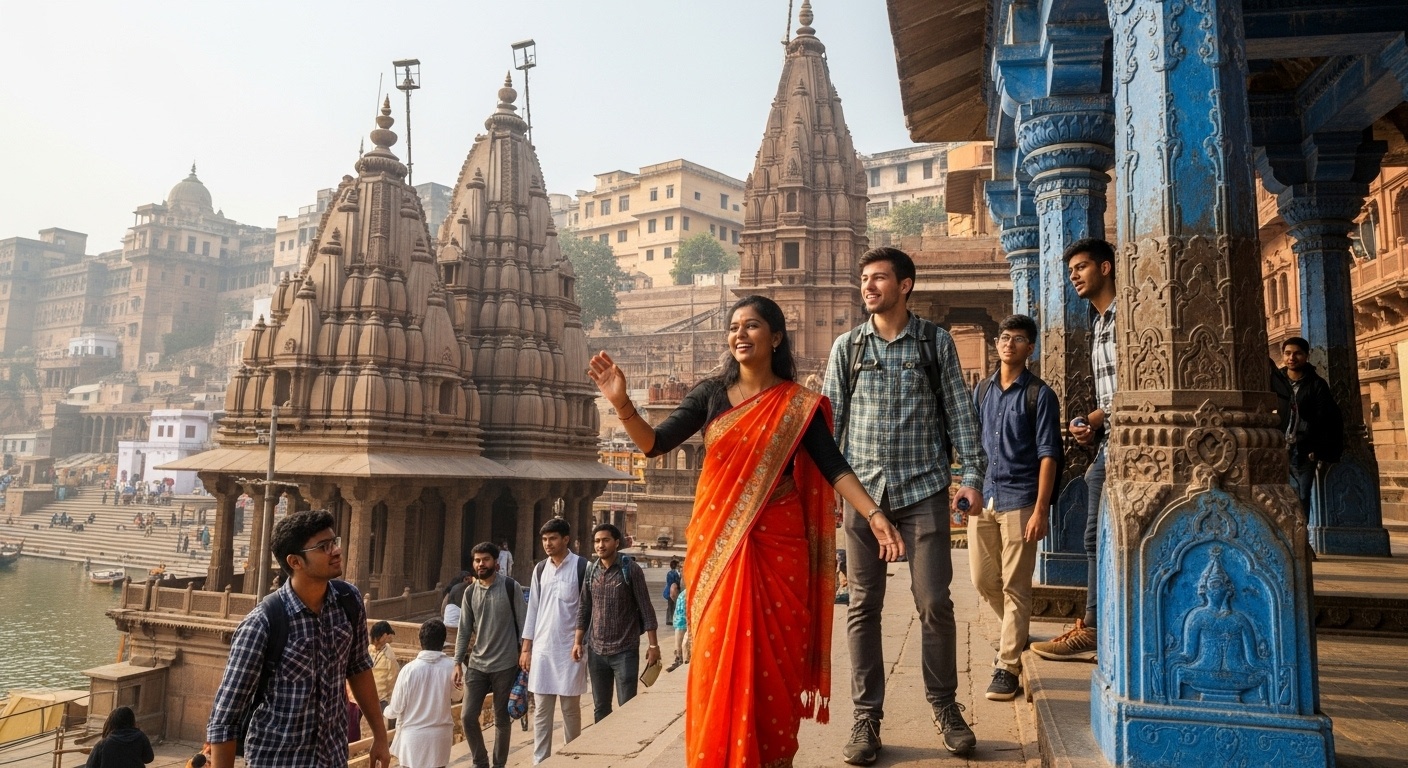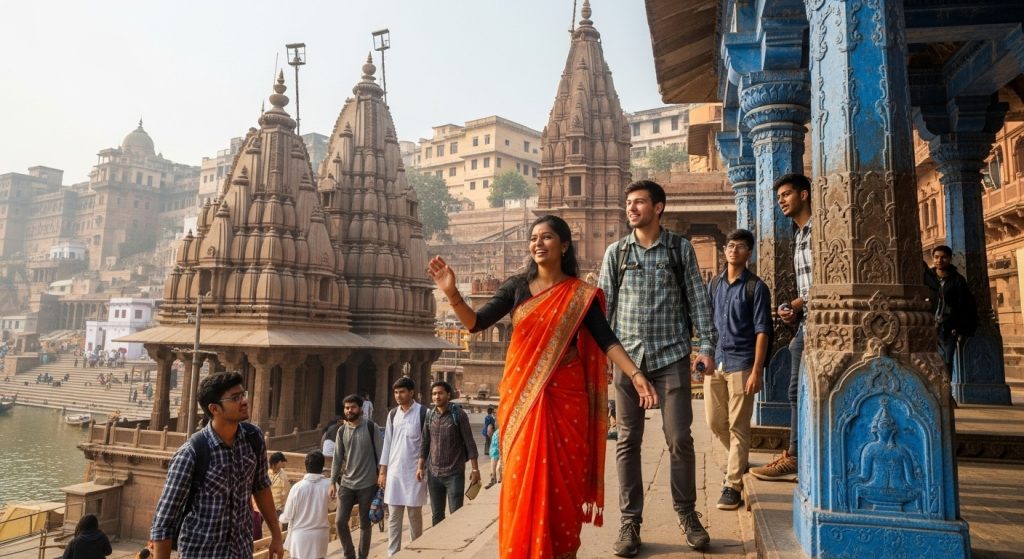Beyond the hallowed halls of Banaras Hindu University lies a tapestry of experiences waiting to be discovered. Forget the usual tourist traps; we’re diving into Varanasi’s soul, focusing on locations easily accessible to BHU students. Imagine swapping late-night study sessions for a dawn boat ride on the Ganges, witnessing the ancient rituals at Assi Ghat, just a short ride away. Or perhaps exploring the Bharat Kala Bhavan museum within the university itself, a treasure trove of Indian art and archaeology, providing a curated glimpse into the region’s rich past. It’s not just about sightseeing; it’s about embedding yourself in the living, breathing culture that defines this ancient city, all while staying within budget and reach.

Assi Ghat: A Spiritual Start
Just a short ride from the Banaras Hindu University (BHU) campus, Assi Ghat marks the southern end of Varanasi’s main ghat stretch. It’s a vibrant hub of activity, especially in the mornings. For students seeking a peaceful start to their day, Assi Ghat offers a serene atmosphere.
- Morning Aarti: Witness the mesmerizing Subah-e-Banaras, a daily morning aarti ceremony, combining music, yoga. Prayer. It’s a truly immersive cultural experience.
- Boat Rides: Hire a boat for a sunrise tour along the ghats. This provides a unique perspective of the city’s architectural beauty and spiritual energy. Bargain for the best price!
- Street Food: Sample local delicacies like aloo tikki, chai. lassi from the numerous vendors around the ghat. Remember to check for hygiene.
- Cultural Events: Assi Ghat often hosts cultural programs, performances. Festivals, providing a great way to experience the local arts. Keep an eye out for announcements.
For BHU students, Assi Ghat is easily accessible by auto-rickshaw or even a pleasant walk, offering a quick escape from academic life.
Sankat Mochan Hanuman Temple: Blessings and Belief
Dedicated to Lord Hanuman, the Sankat Mochan Hanuman Temple is a significant religious site located near BHU. It’s known for its association with the famous Hindu saint, Goswami Tulsidas, the author of the Ramcharitmanas.
- Temple Architecture: Admire the traditional North Indian temple architecture, characterized by its intricate carvings and vibrant colors.
- Prasad Offering: The temple is famous for its “besan ke laddu” prasad, offered to Lord Hanuman. Don’t forget to partake in this sweet offering.
- Peaceful Ambiance: Despite its popularity, the temple maintains a tranquil atmosphere, ideal for quiet reflection and prayer.
- Hanuman Jayanti Celebrations: If you’re in Varanasi during Hanuman Jayanti, the temple hosts grand celebrations with elaborate rituals and processions.
Visiting the Sankat Mochan Hanuman Temple offers a glimpse into the deep-rooted religious beliefs of Varanasi. For students at BHU, it’s a place to seek blessings and find peace of mind.
Durga Kund Temple: A Splash of Color
The Durga Kund Temple, dedicated to Goddess Durga, is another prominent religious site close to BHU. Its distinctive red ochre color and the adjacent kund (pond) make it visually striking.
- Temple Architecture: Observe the Nagara style architecture of the temple, featuring a multi-tiered shikhara (spire) and intricate sculptures.
- Durga Kund: The pond next to the temple is believed to have been connected to the Ganges River in the past. Take a stroll around the kund and enjoy the peaceful surroundings.
- Navratri Celebrations: During Navratri, the temple comes alive with vibrant decorations, special pujas. Cultural performances.
- Local Legends: Learn about the local legends and stories associated with the temple and the goddess.
The Durga Kund Temple is easily accessible from BHU and provides a fascinating insight into the worship of Goddess Durga in Varanasi.
Bharat Kala Bhavan Museum: A Treasure Trove of Art and History
Located within the BHU campus itself, the Bharat Kala Bhavan Museum is a must-visit for students and art enthusiasts. It houses a vast collection of Indian art and artifacts, spanning various periods and styles.
- Collection Highlights: Explore the museum’s diverse collection, including miniature paintings, sculptures, textiles, archaeological finds. Historical documents.
- Painting Galleries: Admire the exquisite miniature paintings from different schools, such as Mughal, Rajput. Pahari.
- Archaeological Section: Discover ancient artifacts excavated from various sites in India, providing insights into the region’s rich history.
- Textile Collection: Examine the intricate designs and craftsmanship of traditional Indian textiles, including brocades, silks. Embroideries.
Being situated within BHU, the Bharat Kala Bhavan Museum is easily accessible for students, offering a convenient and enriching cultural experience. It’s a great place to learn about Indian art, history. Culture.
New Vishwanath Temple (Birla Temple): Modern Marvel
Also located within the BHU campus, the New Vishwanath Temple, often referred to as the Birla Temple, is a modern architectural marvel. Built by the Birla family, it’s dedicated to Lord Shiva and is open to people of all religions and castes.
- Temple Architecture: Marvel at the temple’s contemporary design, combining traditional and modern architectural elements. Its towering structure and white marble façade are particularly striking.
- Inner Sanctuaries: Explore the different shrines within the temple complex, dedicated to various Hindu deities, including Lord Shiva, Goddess Parvati. Lord Ganesha.
- Bhajans and Kirtans: Attend the evening bhajans and kirtans (devotional songs) for a spiritual experience.
- Peaceful Atmosphere: Enjoy the serene and peaceful atmosphere of the temple, ideal for meditation and quiet reflection.
The New Vishwanath Temple, being inside the BHU campus, provides students with a readily accessible space for prayer and contemplation.
Sarnath: A Journey to Enlightenment
While a bit further from the immediate vicinity of BHU, Sarnath, located approximately 10 kilometers away, is an essential destination for anyone interested in Buddhism. It’s the place where Buddha delivered his first sermon after attaining enlightenment.
- Dhamek Stupa: Visit the Dhamek Stupa, a massive cylindrical structure marking the spot where Buddha preached his first sermon.
- Archaeological Museum: Explore the Sarnath Archaeological Museum, which houses a rich collection of Buddhist artifacts, including sculptures, inscriptions. Pottery.
- Ashokan Pillar: See the remnants of the Ashokan Pillar, which once stood tall at Sarnath, symbolizing the emperor’s conversion to Buddhism.
- Various Monasteries: Visit the different monasteries built by various Buddhist countries, each reflecting its unique architectural style and traditions.
Reaching Sarnath from BHU is relatively easy, with auto-rickshaws and taxis readily available. It offers a profound historical and spiritual experience, connecting visitors to the origins of Buddhism.
Ramnagar Fort: A Glimpse into Royalty
Located across the Ganges River from Varanasi, Ramnagar Fort offers a glimpse into the region’s royal history. It’s the ancestral home of the Maharaja of Varanasi.
- Fort Architecture: Explore the fort’s Mughal-style architecture, characterized by its courtyards, pavilions. Durbar Hall.
- Museum: Visit the museum within the fort, which houses a collection of royal artifacts, including vintage cars, weapons, costumes. Furniture.
- Dussehra Celebrations: If you’re in Varanasi during Dussehra, witness the grand celebrations held at Ramnagar Fort, featuring elaborate Ramlila performances.
- Panoramic Views: Enjoy the panoramic views of the Ganges River and the city of Varanasi from the fort’s ramparts.
To reach Ramnagar Fort from BHU, you’ll need to cross the Ganges River, which can be done by boat or by using the Malviya Bridge. It’s a great place to experience the region’s royal heritage and enjoy stunning views.
Conclusion
Exploring Varanasi as a BHU student isn’t just about ticking off tourist spots; it’s about immersing yourself in the city’s soul. Remember, the best experiences often come from wandering off the beaten path. Take a morning boat ride during sunrise – the view of the ghats bathed in golden light is unparalleled. Don’t just observe the Ganga Aarti; interpret its significance by talking to a local priest. Bargain respectfully while shopping for silk sarees. Savor the street food responsibly. Your time in Varanasi is a chance to connect with history, culture. Spirituality, all while building lasting memories with your fellow students. So, step out, explore responsibly, embrace the chaos. Let Varanasi leave an indelible mark on your heart. Embrace the journey and remember, this is your story to write. Let the ancient city inspire your future!
More Articles
NEP 2020 Impact: Transforming State Universities in India for 2025
Boosting the Economy: State University Contributions to India’s Local Growth
Future of Learning: Emerging Trends in State University Education India
Top Infrastructure Investments Enhancing State University Campuses in India
How State Universities Drive Local Innovation in India: 2025 Outlook
FAQs
Okay, so I’m a student at BHU. What are some actually good places to visit nearby? Like, beyond just the Lanka gate chai stalls?
Alright, future Indologist! Beyond the chai, you’ve got a goldmine. Obviously, there’s the New Vishwanath Temple inside BHU. Step outside for Assi Ghat (perfect for morning aarti or evening chill sessions), Durga Kund Temple (super vibrant during festivals). Maybe a little further, Tulsi Manas Temple (dedicated to Ramcharitmanas). Those are your solid starting points. Don’t underestimate the small, hidden temples either – Varanasi is full of them.
Assi Ghat sounds cool. What exactly is there to do there besides just, like, existing?
Existing is a perfectly valid activity in Varanasi! But seriously, Assi Ghat is buzzing. You can catch the Subah-e-Banaras aarti (morning prayer ceremony) which is incredibly peaceful. There’s usually a small market selling local handicrafts. You can take a boat ride along the Ganges, learn yoga, or just people-watch. It’s a good place to grab some street food too – just be mindful of hygiene!
How far away are these spots from BHU, roughly? I don’t want to end up trekking for hours.
Good point! Assi Ghat is super close, maybe a 15-20 minute auto-rickshaw ride from the BHU gate (Lanka). Durga Kund and Tulsi Manas are slightly further, maybe 20-30 minutes depending on traffic. Honestly, the auto-rickshaw (tuk-tuk) is your best friend in Varanasi. Bargain hard!
Is it safe for students, especially girls, to be out and about in these areas, particularly in the evening?
Safety is always vital. Varanasi is generally safe. Like any city, it’s good to be aware. Stick to well-lit and populated areas, especially at night. Avoid walking alone late at night. Let someone know where you’re going. Assi Ghat is usually quite crowded even in the evening, which adds a layer of security. Trust your gut. If a situation feels off, remove yourself. Also, dressing modestly is always a good idea in religious places.
Durga Kund Temple… what’s the deal with that? Is it just another temple?
It’s not just another temple! Durga Kund is dedicated to Goddess Durga. It’s particularly known for its red color and the large kund (pond) next to it. It’s a really active temple, especially during Navratri, when it’s absolutely packed with devotees. It’s a great place to experience the vibrant religious culture of Varanasi.
Okay, budget traveler here. How much money should I roughly budget for a day trip to these places, including transport and food?
Varanasi is very budget-friendly! Transport (auto-rickshaw) for the whole day shouldn’t cost more than ₹300-₹400 if you bargain well. Street food is super cheap, you can easily eat a filling meal for ₹100-₹200. Entry to temples is usually free. You might want to donate a small amount. So, for a full day exploring, you could easily get by on ₹500-₹800. Of course, souvenirs will add to the cost!
Any insider tips for a first-timer in Varanasi? Things I should definitely do or avoid?
Definitely take a boat ride on the Ganges – it’s a must-do! Be prepared for crowds, especially during peak season and festivals. Be respectful of religious customs and dress modestly when visiting temples. Bargain hard when shopping or hiring transport. Try the local lassi and street food (but be mindful of hygiene!). And most importantly, be open to the experience. Varanasi can be overwhelming. It’s also incredibly rewarding.



